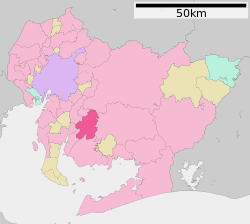Anjō
City in Chūbu, Japan From Wikipedia, the free encyclopedia
City in Chūbu, Japan From Wikipedia, the free encyclopedia
Anjō (安城市, Anjō-shi) is a city in Aichi Prefecture, Japan. As of 1 October 2019[update], the city had an estimated population of 188,693 in 76,087 households,[1] and a population density of 2,193 persons per km². The total area of the city was 86.05 square kilometres (33.22 sq mi).
Anjō
安城市 | |
|---|---|
  Upper stage: Den Park Lower stage: Skyline of Mikawaanjō | |
 Location of Anjō within Aichi Prefecture | |
| Coordinates: 34°57′31.4″N 137°4′49.2″E | |
| Country | Japan |
| Region | Chūbu (Tōkai) |
| Prefecture | Aichi |
| Government | |
| • Mayor | Gaku Kamiya |
| Area | |
| • Total | 86.05 km2 (33.22 sq mi) |
| Elevation | 10 m (30 ft) |
| Population (October 1, 2019) | |
| • Total | 188,693 |
| • Density | 2,200/km2 (5,700/sq mi) |
| Time zone | UTC+9 (Japan Standard Time) |
| – Tree | Japanese Black Pine |
| – Flower | Scarlet Sage |
| Phone number | 0566-76-1111 |
| Address | 18–23 Sakuramachi, Anjō-shi, Aichi-ken 446-8501 |
| Website | Official website |


Anjō is situated in southern Aichi Prefecture, approximately 30 kilometres (19 mi) from central Nagoya, in the center of the Okazaki Plain, on the west bank of the Yahagi River. National Route 1 and National Route 23 provide the main east-west access through the city, with Aichi Prefectural Route 48 running between the two.
The city has a climate characterized by hot and humid summers, and relatively mild winters (Köppen climate classification Cfa). The average annual temperature in Anjō is 15.6 °C. The average annual rainfall is 1576 mm with September as the wettest month. The temperatures are highest on average in August, at around 27.7 °C, and lowest in January, at around 4.4 °C.[2]
Per Japanese census data,[3] the population of Anjō has grown rapidly over the past 70 years.
| Year | Pop. | ±% |
|---|---|---|
| 1940 | 46,737 | — |
| 1950 | 61,037 | +30.6% |
| 1960 | 66,793 | +9.4% |
| 1970 | 94,307 | +41.2% |
| 1980 | 123,843 | +31.3% |
| 1990 | 142,251 | +14.9% |
| 2000 | 158,824 | +11.7% |
| 2010 | 178,738 | +12.5% |
The area of present-day Anjō has been continuously occupied since preshistoric times. Archaeologists have found numerous remains from the Japanese Paleolithic period and burial mounds from the Kofun period.
During the Nara period, the area was assigned to ancient Hekikai County, and was divided into several shōen during the Heian period, largely under the control of the Fujiwara clan or the Taira clan.
However, in the Kamakura period, parts of the territory came under the control of the Jōdo Shinshū sect, who challenged the secular authority of the various samurai clans, most notably the Matsudaira clan.
During the Sengoku period, numerous fortifications were erected in the area.
Tokugawa Ieyasu unified the region and destroyed the power of the Jōdo Shinshū sect in the Battle of Azukizaka (1564). During the Edo period, half of present-day Anjō was controlled by Okazaki Domain and the other half by Kariya Domain under the Tokugawa shogunate with some scattered portions of tenryō territory ruled directly by the shogunate. During this period, the area was noted for its production of cotton and textiles.
At the start of the Meiji period, on October 1, 1889, Anjō was one of a collection of villages organized within Hekikai District, Aichi Prefecture by the establishment of the modern municipalities system. It was elevated to town status on May 1, 1906. The opening of the Meiji Irrigation Canal transformed the area in the 1920s and 1930s into one of the most agriculturally productive regions of the period, sparking the comparison with Denmark, then regarded the most highly advanced agricultural nation in the world.[4] This led to Anjō's moniker of "Japan's Denmark" (日本デンマーク), which remains in the form of Den Park, a Danish theme park, as well as Den Beer, a microbrew available in the park.
Anjō was elevated to city status on May 3, 1952. On April 1, 1967, it annexed the neighboring town of Sakurai.

Anjō has a mayor-council form of government with a directly elected mayor and a unicameral city legislature of 28 members. The city contributes two members to the Aichi Prefectural Assembly. In terms of national politics, the city is part of Aichi District 13 of the lower house of the Diet of Japan.
Anjō is a regional commercial center with a mixed economy of manufacturing and agriculture.
In addition to rice, wheat, and soybeans, notable agricultural products include figs, Japanese pears, and cucumbers.
Due to its proximity to the various factories of Toyota in neighboring Toyota City, Anjō is host to many factories supplying components into the automobile industry.
Primary and secondary education
The Tōkaidō Shinkansen stops at Mikawa-Anjō Station, but Anjō Station on the Tōkaidō Main Line and Shin Anjō Station on the Meitetsu Nagoya Main Line and Nishio Line serve the commercial center of the city.

| Sex | Name | competition | League | Home | Sponsor | Since |
|---|---|---|---|---|---|---|
| Men | Aisin Areions | Basketball | B.League (B3) | Aisin AW Gymnasium・Anjō City Gymnasium | Aisin | 1978 |
| Women | Denso Bright Pegasus | Softball | Japan Softball League (JSL) | Anjo Sports Park Softball Field | Denso | 1960 |
| Women | Aisin Wings | Basketball | W.League | Aisin AW Gymnasium・Anjō City Gymnasium | Aisin | 1979 |
Seamless Wikipedia browsing. On steroids.
Every time you click a link to Wikipedia, Wiktionary or Wikiquote in your browser's search results, it will show the modern Wikiwand interface.
Wikiwand extension is a five stars, simple, with minimum permission required to keep your browsing private, safe and transparent.